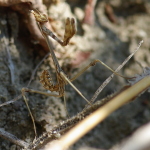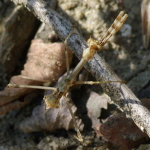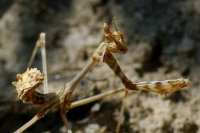Phylum Arthropoda (Arthropods) ➔ Subphylum Hexapoda (Hexapods) ➔ Class Insecta (Insects) ➔ Order Mantodea (Mantids) ➔ Family Empusidae
Empusa fasciata Brullé, 1839
Classification:
Empusa fasciata belongs to the subfamily Empusinae, tribe Empusini.Distribution:
From Italy eastwards through south-eastern Europe to Ukraine, Near EastHabitat:
Warm and dry habitats with low vegetation and scattered shrubsDescription:
Males: body length 50 - 70 mm; wings protruding beyond the abdomen; antennae bipectinate and long.Females: body length 60 - 80 mm; wings long; abdomen strong; antennae thin and short.
Similar species:
A similar species is Empusa pennata, which occurs from the Iberian Peninsula to France and Italy and in North Africa.Biology:
The adults of Empusa fasciata can be found predominantly from the beginning of May to the end of June. They are ambush predators, well-camouflaged waiting for prey in the vegetation. Preferred prey animals are flying insects such as bees or flies.After mating one or more times, the eggs are laid by the females in small packages (oothecae) that are attached to vegetation. The young larvae hatch about 2 - 3 weeks after the eggs are laid. These predatorily feed on insects, increase in size and molt at least 5 times during their development. Final moulting happens after a winter diapause in the following spring.
Empusa fasciata is diurnal and able to fly. The species forms one generation per year.
Natural enemies:
Birds, shrews, batsReferences, further reading, links:
- de Jong, Y.S.D.M. (ed.) (2013) Fauna Europaea version 2.6.2 Web Service available online at https://fauna-eu.org/
- Stanislav Gomboc (2000): Bionomie, Verbreitung und Züchtungsversuche an Empusa fasciata BRULLE, 1836 (Mantodea, Empusidae) in Slowenien – Articulata - Zeitschrift der Deutschen Gesellschaft für Orthopterologie e.V. DGfO – 2000 15(1): 1 - 6.


